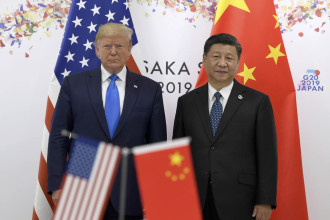
BEIJING: The economic performance of China for the first quarter of this year was revealed on Tuesday, demonstrating a robust start with substantial growth and enhanced quality and efficiency.
From January to March this year, China's gross domestic product (GDP) increased by 5.3% year on year to 29.63 trillion yuan (approximately $4.17 trillion), while fixed-asset investment and investment in high-tech industries rose by 4.5% and 11.4%, respectively.
Furthermore, the surveyed urban unemployment rate was at 5.2% in March, a decrease of 0.1 percentage points compared with both February this year and March 2023, indicating a generally stable employment situation.
The national economy has maintained recovery momentum and made a strong start, as stated by Sheng Laiyun, the deputy head of the National Bureau of Statistics, at a press conference.
Sheng said, "These positive factors driving economic recovery are accumulating and strengthening, laying a solid foundation for growth throughout the year."
However, in the face of a challenging and complex external environment, issues such as insufficient effective demand and weak social expectations persist in the country. More efforts are required to consolidate and enhance the positive momentum of the economic recovery.
WELL BEGUN IS HALF DONE
In the Panyu District of Guangzhou, the capital of southern China's Guangdong Province, the GAC Group's Aion new energy automotive factory can assemble a new energy vehicle (NEV) in a mere 53 seconds.
"Last year, GAC Aion produced and sold over 480,000 vehicles, marking a year-on-year increase of 77%. This year, we plan to accelerate our globalisation efforts and expand our market to Southeast Asia, the Middle East, Europe, South America, and Africa, with the aim of increasing production and sales," stated Zheng Chunqi, the deputy general manager of GAC Aion.
In the first quarter, nationwide investment in high-tech manufacturing and high-tech services increased by 10.8% and 12.7%, respectively. Energy consumption per unit GDP decreased by 0.1%, and NEV production surged by nearly 30%, all of which indicate the ongoing transformation and upgrading of the Chinese economy.
Experts highlight that the performance in the first quarter is significant -- a strong start can bolster confidence and positively impact subsequent economic operations.
Recently, several international financial institutions have expressed optimism about China's economic prospects. Goldman Sachs raised its outlook for China's economic growth this year to 5%, up from its previous prediction of 4.8%. Citigroup also revised its forecast from 4.6% to 5%, expecting China to achieve its 2024 growth target.
"For every one percentage point increase in China's growth, that raises the level of GDP in other economies in the medium term by about 0.3% on average," said Steven Alan Barnett, the senior resident representative in China of the International Monetary Fund, adding that China continues to be a significant engine driving global economic growth.
Media outlets have emphasised the positive signals of China's economic statistics in the first quarter, with some describing it as "better than expected" and indicative of "a recovery in confidence."
Although there were concerns about "severe challenges" and "difficulties in achieving the targets," Ajay Banga, the president of the World Bank Group, believed that the challenges facing China's economy are not unique but are occurring on a global scale, noting that the path of development is never smooth.
"We have faced challenges before -- and overcome them. Together. China's remarkable journey stands as a testament to what's possible," he said at the China Development Forum last month.
SUIT THE REMEDY TO THE CASE
At the restoration project of the Dashihe River in Beijing's Fangshan District, which was severely affected by a flood last year, workers are actively engaged in mixing mortar and laying bricks, with excavators and cranes operating continuously.
"The project is expected to be completed by the 31st of May this year," stated the project director. The total investment in the project is approximately 357 million yuan, of which about 250 million yuan was sourced from additional government bonds issued last year.
Last October, the Chinese central government decided to issue an additional 1 trillion yuan in government bonds in the fourth quarter of 2023. This move was aimed at supporting the reconstruction of areas devastated by disasters and enhancing the country's disaster relief capabilities.
Furthermore, a series of measures to stimulate growth this year were disclosed in the government work report. These include 3.9 trillion yuan of special-purpose bonds for local governments and 1 trillion yuan of ultra-long special treasury bonds.
The prevention and defusing of risks, particularly in the local debt and property sectors, is another topic of significant interest.
According to the Ministry of Housing and Urban-Rural Development, a coordinated financing mechanism for urban property has been established nationwide. A "white list" of real estate projects eligible for financing support has been issued to commercial banks.
As of the 31st of March, among the eligible projects, 1,979 have been granted credit by banks totalling 469.03 billion yuan, and 1,247 have received loans amounting to 155.41 billion yuan.
Efforts are ongoing to improve city-specific policies on real estate regulation, relax purchase restrictions, reduce interest rates on housing mortgages, and ensure the delivery of housing projects.
Regarding the debt risks and fiscal sustainability of local governments, industry insiders believe that China's government debt is somewhat overstated. China's government debt ratio has remained stable and is at a medium-low level globally.
Tian Xuan, the vice dean of Tsinghua University's PBC School of Finance, stated that the key is to accurately implement policies and measures, deepen reforms in key areas and industries, and enhance the business environment. This approach will lay a solid foundation for achieving this year's development goals.
VITALITY, POTENTIAL MAKE TARGET ACHIEVABLE
In Sunzhuang Village of Caoxian County, Shandong Province, an express delivery centre is brimming with traditional Chinese attire, known as Hanfu.
"The village boasts over 2,600 Taobao stores and more than 200 Tmall stores (both are Alibaba's online shopping platforms), along with over 500 merchants on other online platforms," stated Sun Xueping, the village's Party secretary.
During this year's Spring Festival, sales of Hanfu in Caoxian County surpassed 300 million yuan, and online sales in the first quarter reached 1.98 billion yuan, marking a year-on-year increase of 90.8%.
China's electricity consumption, a key indicator of economic activity, rose by 11% year on year to 1.53 trillion kilowatt-hours in the first two months of this year, according to the National Energy Administration.
Specifically, power consumption by the high-tech and equipment manufacturing industry increased by 16.9%.
In March, the central government announced a plan to promote large-scale equipment upgrades and trade-ins of consumer goods. This initiative is part of its efforts to stimulate domestic demand and support sustained economic growth, which is likely to generate a market worth over 5 trillion yuan annually.
In Liuyang City, located in central China's Hunan Province, nearly 1,600 units in a residential compound were recently sold out, with the majority of buyers being rural residents who have settled or plan to relocate to cities amid the country's urbanisation process.
Zhang Heming, a resident from a nearby town, had already purchased another house in the city and is now enjoying city life. "The city offers better job opportunities and education," he said.
Currently, China's urbanisation rate is 66.16%, which is considerably lower than the average level in developed countries. It is estimated that for every 1-percentage-point increase in China's urbanisation rate, it can stimulate approximately 1 trillion yuan in new investment demand and over 200 billion yuan in new consumption demand.
"The Chinese economy faces headwinds. Yet, I believe that China can -- and indeed will -- continue on its path of rapid economic development," said Jeffrey Sachs, a professor and director of the Center for Sustainable Development at Columbia University.
By RSS/Xinhua






